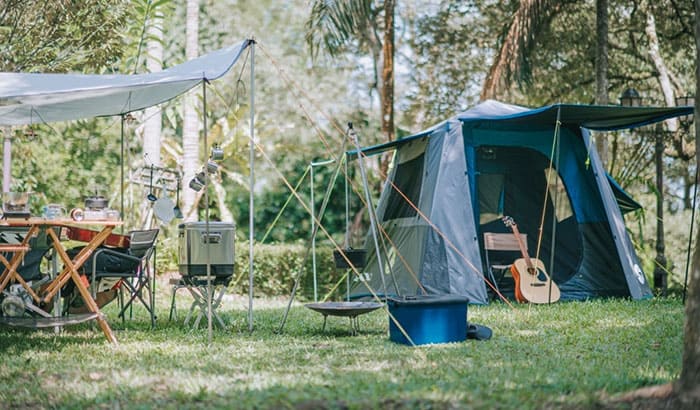A tent is very essential when it comes to spending your time outdoors. It offers a space for comfort during the night. But what is the difference between 3 season vs 4 season tents? Please see below to find out.
| Features | 3 Season Tents | 4 Season Tents |
| Primary Purpose | Backpacking, Campouts | For Extreme Weather |
| Materials | Light Fabrics | Durable Fabrics |
| Construction | Double Walling | Rigid Shapes and Pole
Geometries |
| Tent Body | Mesh | Without Mesh |
| Weight | Light and Portable | Heavy Duty |
3-Season Tent: All-Year Backpacking Tent
The 3 season tent is considered an all-year tent. They are specifically designed to be used year-round in three different weather conditions: spring, summer, and fall. If you are making spring trekking, backpacking trips during the summer, and campout during fall, this tent is perfect for these outdoor activities.
The 3 season tents are designed and built to be light. This feature is the reason why it is ideal for backpacking, trekking, and campouts. They are made to protect the camper from the threats of rain and wind. The tent is prioritizing more on ventilation for the comfort of the user.
Other Features and Functionalities:
3 season tents are designed to be lighter, which means manufacturers use more delicate fabrics for their construction. Since ventilation is the priority, you will see more mesh on the design in order to have more breathability and airflow. In addition, most of the 3 season tents come with double walling construction to promote versatility.
It also comes with a rain cover on the side, which usually sits off the ground. This small feature will let the air move in quickly to allow more ventilation. Lightness can also be found on the body and the flooring materials, making it less bulky and lighter. The pole setups and aluminum frames are also very light but can still survive possible weather threats.
The weight of a 3 season tent should be around 3 to 6 lbs which are pretty light for anyone. Most of the manufacturers are finding ways to make them lighter, especially in the assembly. For example, some are now using clips in attaching the poles for the tent to be lighter. Trekking poles are also being used to eliminate further the weight that the camper carries.
Lastly, the 3 season tent is not built for harsh and extreme weather conditions. They are made for all the outdoor activities you can do during summer, spring, and fall. More importantly, it is not built for the winter season where extreme weather conditions usually happen.
4 Season Tent: Built for the Winter Season
The primary purpose of a 4 season tent is to protect the camper from harsh weather conditions, which usually happens during the winner. It feels so uncanny that it is named a “4 season tent,” yet it is mainly used during the winter. This tent will protect the user from harsh winds and snowy conditions during the winter season.
The 4 season tent is built and designed to keep the user safe from different extreme weather. It is built to protect the occupant from snow, hail, ice, snow buildup, and even high winds. In other words, they are made to be solid and sturdy to survive everything that these extreme weather conditions bring to the tent.
The 4 season tent also features rigid pole geometries and shapes to allow the tent to stand powerful winds and heavy snow loads. It also uses a more durable fabric that has the ability to survive on snows, ice, and even rocks located in the alpine environment.
Since this tent is also used in the winter, it must make sure that it provides warmth to the occupant. So, the design is entirely opposite to the 3 season tent as mesh windows are not found on the body to keep the tent closed as much as possible to create a warm environment inside.
Other Features and Functionalities
Even if the walls of this tent are mesh-free, polyester is being used to trap body heat while also blocking gusty winds. Instead, this tent comes with vents to allow it to open up for the control of the condensation inside the tent. However, this situation is usually not an issue when in colder climates.
In terms of the size of the tent, the 4 season tent usually comes with a larger space if you compare it to the typical 3 season tent. This feature aims to allow the hikers to move freely, even in their usually bulky winter gear. This tent also features a large hooped rainfly which helps create added space for basically a week or more worth of climbing gear.
In addition, the rain fly is also being used to extend the ground coverage while also blocking the wind completely. It also comes with flaps that have the ability to fold inward to allow snow to be packed. This feature will result in increased stability and more excellent protection from threats outside.
Also, the frame design is a little bit thicker and more robust as it uses dependable aluminum materials. It also comes with a full fabric sleeve feature that can be used to improve the tent’s strength and stability. The sleeves also help in making the setup very light and easy.
The pole in the 4 season tent is being utilized to give excellent framing and protection around the tent. It helps improve the tent’s stability, especially when dealing with gusts, while helping it hold up against the weight of the accumulated snow or ice. The average weight of a 4 season tent is between 8 to 16 lbs, although some companies have made even lighter tents.
Conclusion
Learning the difference between 3 seasons vs 4 season tents should not be a problem. The 3 season tent is used mainly in summer, spring, and fall, while the 4 season tents are a perfect fit for winter seasons. However, some other factors such as the environment can also influence the choice of your tent.


